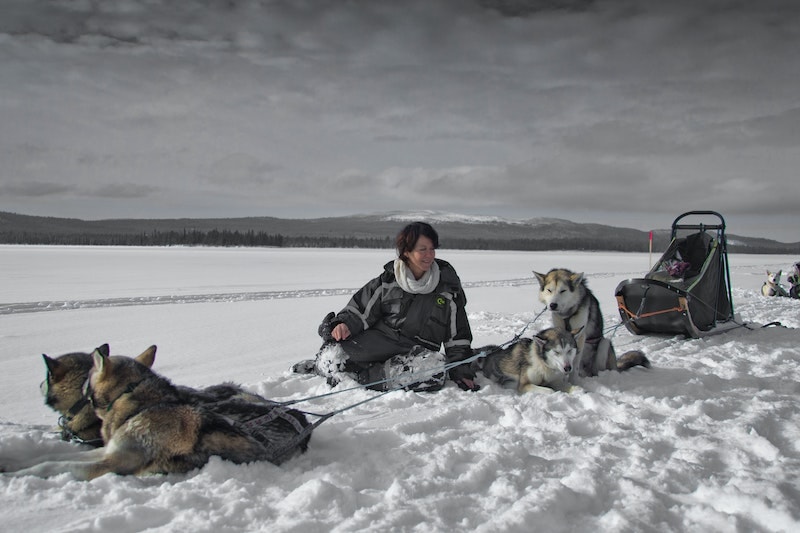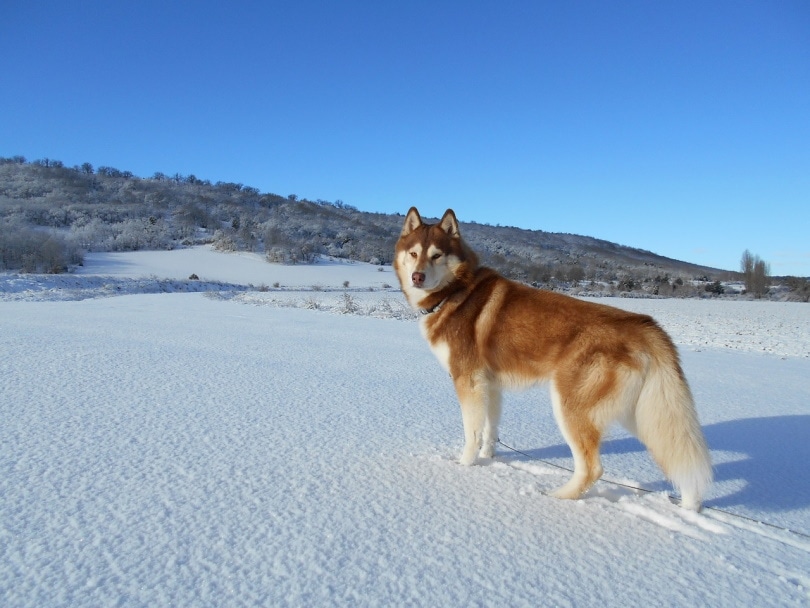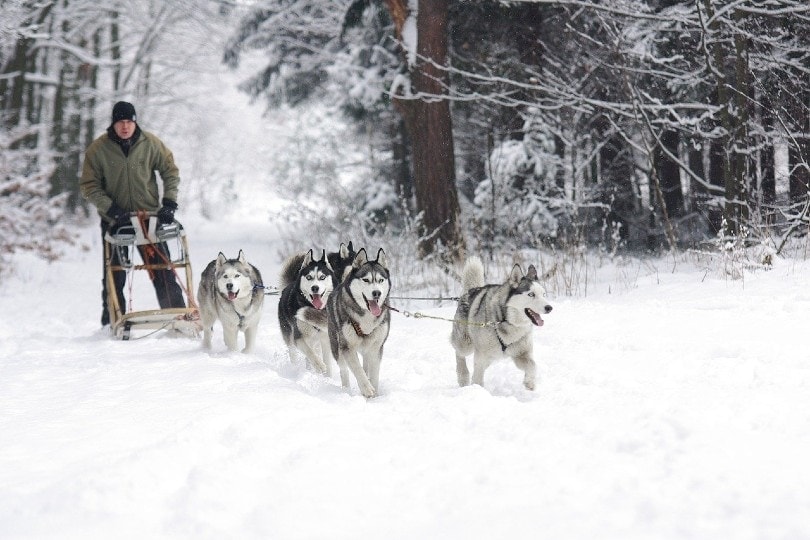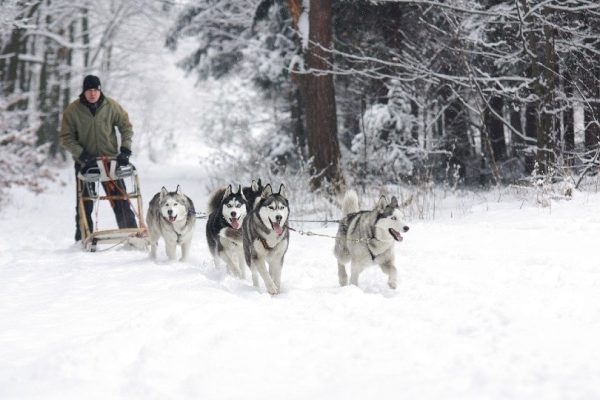Dogs are a man’s best friend today, but they used to be man’s right-hand man. There are many different working breed dogs, but perhaps none as hardworking as the sled dog.
Sled dogs are trained to wear a harness and pull a sled through harsh and frigid lands. Northern Indigenous peoples relied on these dogs to transport sleds full of game, wood, fish, and other goods across otherwise untraversable winter terrain. The sled dog has a long and interesting history that goes beyond acting as a workhorse for man.
Come along with us as we explore the fascinating facts about sled dogs.
The 11 Facts About Sled Dogs
1. Dog Sledding Has Been Around for Thousands of Years
It’s hard to pinpoint an exact date when dog sledding came to be. Some reports suggest that the earliest records of dog sledding date back to 1000 A.D., while other sources report finding evidence that dog sleds were used over 9,000 years ago. As far as archaeologists know, dog sledding was created by the Inuit and native people in the northern parts of what is now Canada.
But, of course, this mode of transportation looks much different today than it did then. Early sleds were usually pulled by a single dog and only contained minimal cargo. The need for larger sleds and more dogs came when people realized they could transport larger loads further distances when the weight was evenly distributed amongst more dogs.

2. Dog Mushing Is Alaska’s State Sport
In 1972, dog mushing became the official state sport of Alaska. Many residents keep sled dogs for recreational mushing, and it is one of the state’s staple tourism activities. Some dog sledding companies have tour offerings throughout the year. You can ride on a wheeled cart during the summer months and experience mushing in the snow during the winter.
3. Sled Dogs Saved Nome, Alaska
Balto, a Siberian Husky sled dog, achieved fame in 1925 when he saved the town of Nome, Alaska. In January 1925, doctors realized that a deadly Diphtheria outbreak would spread throughout the city and was poised to decimate much of the population. The only thing the people of Nome could do to protect themselves was secure the serum to stop the outbreak, but this serum was in Anchorage, 540 miles away. In addition, the engine of the only plane that could deliver the medication would not start, and the outbreak was closing in on them.
Officials finally decided to use dog sled teams to get the serum to the people of Nome. Balto was the lead sled dog on the final stretch into Nome, facing a blizzard that almost made the trek back into the city impossible. Balto knew the trail by scent and was able to lead the rest of the team the 50 miles after a long and trying 20-hour journey. The diphtheria outbreak was avoided, and Balton became famous for his work. There’s even a statue of him in Central Park.

4. There’s an Annual Dog Sled Race in Alaska
The Iditarod is a dog sled race that occurs every March and is said to commemorate the 1925 serum delivery. The race attracts hundreds of participants and their team of sled dogs. The first Iditarod happened in 1973 with just 34 mushers.
The course of the Iditarod is between 975 and 998 miles long and crosses two mountain ranges. The route varies yearly; the length will depend on whether the southern or northern course is run. Weather conditions can also determine the length of the race.
Only one musher is allowed per team; each team can consist of between 12 and 16 dogs. To be considered a finisher, at least five dogs must be pulling the sled when it reaches the finish line.
The Iditarod is controversial amongst animal protection activists. They do not believe the race commemorates the serum delivery but instead think it is animal abuse. Several dogs have been hurt during the race, and some have even died due to their participation.
5. Many Dog Breeds Can Become Sled Dogs
There is not one particular dog breed that can become a sled dog. In fact, several breeds are well-suited for the position. Sled dogs must be lean, strong, adaptable to the cold weather, and attentive. In addition, they need to have thick double coats for insulation and a fluffy tail to provide nose cover during cold nights.
Most sled dogs are Siberian Huskies or Alaskan Malamutes, but other breeds do well in this position and Samoyeds and Chinooks.

6. A Dog Doping Scandal in 2017 Took the Iditarod World By Storm
One of the most high-profile scandals associated with the Iditarod involves a musher named Dallas Seavey. Seavey became embroiled in a dog doping scandal in 2017 when it was discovered that a banned substance was found in four dogs from his team. The dogs tested positive for tramadol, a synthetic opioid used as a painkiller.
Seavey denied involvement in the doping of his dogs and instead suggested that a rival racer was trying to sabotage him. Eventually, he was cleared and not disciplined. Seavey went on to take a few years off from the sport, returning in 2021 to win first for the fifth time.
The scandal made headlines worldwide and brought into question the morality of the race.
7. There Are Four Sledding Positions in a Team
Sled dogs aren’t chosen randomly. Instead, they hold a particular position depending on their skill set and agility and are given titles based on their position in relation to the sled.
Lead dogs steer the team and set the pace. There can be either one or two leaders, with the latter being more common now.
Swing dogs are found right behind the leader. Their main job is to steer the rest of the team around corners. When lead dogs go to make a turn, it’s not unusual for the others to want to jump off the train so they can follow the leader. The swing dog keeps everyone in an arc to ensure the rest of the dogs stay on the trail.

Team dogs are the brawn and power behind the group. Sled pulling and maintaining sled speed are their main jobs. If the team is large, there are often numerous pairs of team dogs. Sometimes there may not be a team dog at all if the team is small.
Wheel dogs are the closest ones to the sled and musher. They need to be calm so as not to become afraid of the sled moving right behind them. The best wheel dogs are also strong and steady as they need to help guide the sled around tight corners. The wheel dogs are often the largest because they take on the sled’s weight before any of the other pups on the team.
8. Mushing Is a Sport Powered by Sled Dogs
Mushing refers to both a sport and a mode of transportation powered by canines. It includes sports like carting, pulka, sled racing, and skijoring, amongst others.
Carting is sometimes also referred to as dryland mushing. It is practiced worldwide and is a great sport to keep winter sled dogs conditioned during the off-season.
Pulka is a winter sport originating in Scandinavia that integrates a sled, skier, and dogs. In this sport, dogs get harnessed to a pulka (sled), and the skier uses a strap to attach themselves to the pulka. This sport requires more coordination than traditional dog sledding as the skier must control both themselves and the dogs.
Skijoring is a sport where a dog or horse pulls a skier. One to three dogs are most often used. The skier will propel themselves forward with their skis and poles, and the dog will provide extra power through running and pulling.
9. Sled Dogs Need to Wear Booties
Dogs wear colorful booties during races. These booties are less of a fashion statement and more of a safety thing. The boots protect the feet from rubbing on coarse snow or ice, which can cause severe damage to the paw pads. Ice can also become jammed between toes and cause discomfort during races.
During the Iditarod, mushers must have a minimum of eight pairs for every dog, though most dogs will go through many more than this during the race.

10. Sled Dogs Were Integral to the Gold Rush
Sled dogs became very popular throughout Northwestern Canada and Alaska during the late 19th and 20th centuries because of the Gold Rush. Most of the gold camps became accessible only by dog sled during the winter. Therefore, anything that needed to move during the winter months of the year was moved by the dog team, including prospectors, trappers, doctors, and supplies.
Dogs were so popular during this time that some historians report no stray dogs on Seattle’s streets. Instead, all of the dogs were rounded up and sent to Canada and Alaska
11. Sled Dogs Eat Up to 10,000 Calories Per Day
Being a sled dog requires a lot of energy, so they need to eat enough food to fuel themselves. The average sled dog burns 12,000 calories per day during their runs, so you can imagine the amount of fuel they need to power through. Most sled dogs can eat up to 10,000 calories per day during the sledding season, compared to the roughly 1,500 calories a “normal” dog needs.
In the off-season, sled dogs can follow a more traditional diet. However, it’s during their runs that proper nutrition becomes essential. Without the right fuel, the dog won’t be able to run or perform as they need to.

Final Thoughts
Sled dogs have a long history dating back thousands of years and are still used in rural communities in Greenland, Russia, Canada, and Alaska. Whether you support dog sledding as a sport, there is no denying the sheer strength and power behind these big beautiful dogs.
Be sure to check out our blog on sled dog breeds to learn what characteristics each breed has that lend well to dog sledding.
Featured Image Credit: badamczak80, Pixabay
Contents
- The 11 Facts About Sled Dogs
- 1. Dog Sledding Has Been Around for Thousands of Years
- 2. Dog Mushing Is Alaska’s State Sport
- 3. Sled Dogs Saved Nome, Alaska
- 4. There’s an Annual Dog Sled Race in Alaska
- 5. Many Dog Breeds Can Become Sled Dogs
- 6. A Dog Doping Scandal in 2017 Took the Iditarod World By Storm
- 7. There Are Four Sledding Positions in a Team
- 8. Mushing Is a Sport Powered by Sled Dogs
- 9. Sled Dogs Need to Wear Booties
- 10. Sled Dogs Were Integral to the Gold Rush
- 11. Sled Dogs Eat Up to 10,000 Calories Per Day
- Final Thoughts











